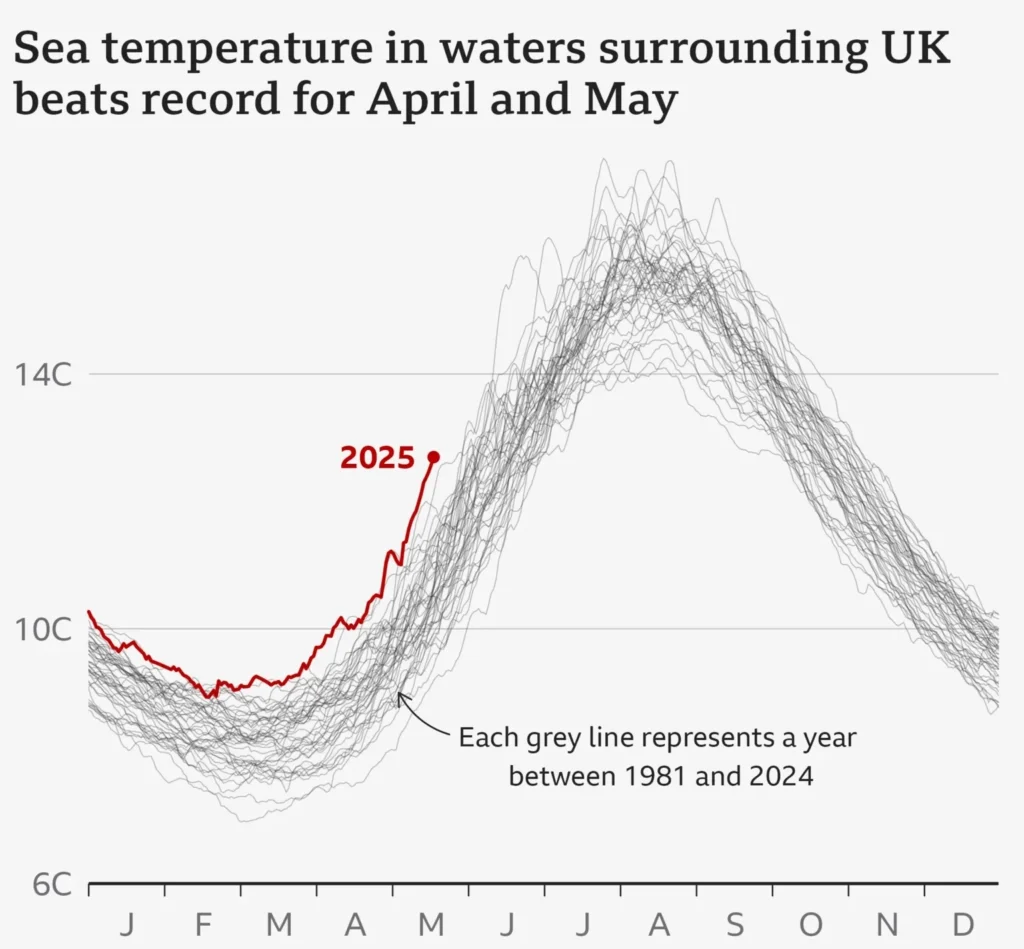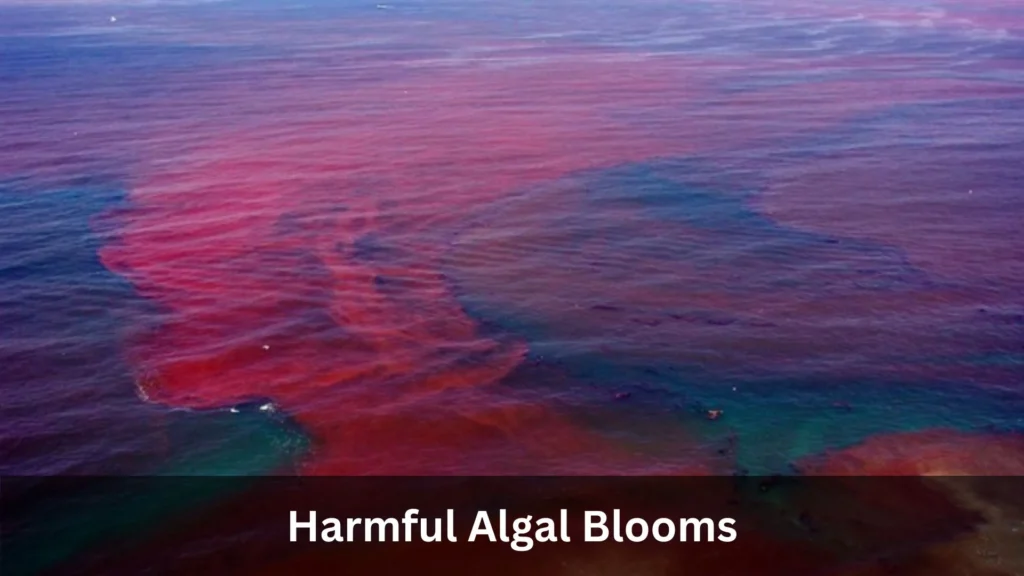Key Takeaways
- Marine heatwave UK Ireland: Sea temperatures around the UK and Ireland have surged, with some areas experiencing anomalies up to 4°C above average.
- The prolonged heatwave is disrupting marine ecosystems, affecting species distribution and potentially leading to harmful algal blooms.
- Experts warn that such events are becoming more frequent and intense due to climate change, with significant implications for fisheries and coastal communities.
- Immediate research and adaptive strategies are essential to mitigate the long-term impacts on marine biodiversity and the economy.
Introduction: A Silent Crisis Beneath the Waves
From the rugged coastlines of Scotland to the scenic harbors of Ireland, the seas surrounding the British Isles have long been a cornerstone of ecological richness and economic activity. Yet, in recent months, this tranquil marine expanse has become the site of a troubling phenomenon: a marine heatwave of unusual intensity and duration.
Unlike heatwaves on land, which garner immediate attention, marine heatwaves unfold subtly beneath the ocean’s surface, often going unnoticed until the ecological damage becomes evident. These elevated sea temperatures are now threatening to reshape the marine environment, disrupt traditional fisheries, and challenge long-standing ecological balances.
What is a Marine Heatwave?
A marine heatwave is characterized by a prolonged period—usually at least five consecutive days—during which sea surface temperatures (SSTs) are significantly higher than the expected seasonal average for a given region.
But these are not ordinary fluctuations. Marine heatwaves can be as disruptive to ocean ecosystems as droughts or wildfires are on land. In addition to altering animals, ecosystems, and even weather patterns, the heat can reach well below the ocean’s surface. Depending on their intensity, maritime heatwaves fall into several categories:
- Moderate: Slightly above average temperatures
- Strong: More significant deviation from the norm
- Severe: Major disruption with ecological consequences
- Extreme: Record-breaking temperatures with catastrophic effects
The current marine heatwave affecting the UK and Ireland falls between the “severe” and “extreme” categories, based on observed temperature anomalies and biological impacts.
Current Situation: Waters Far Warmer Than Expected
Marine researchers and climate scientists monitoring the North Atlantic region have observed sea surface temperatures up to 4°C above the long-term average in some coastal zones around the UK and Ireland. While temperature variability in the ocean is natural, this sustained and widespread warming is abnormal.

Key hotspots include:
- The Celtic Sea
- Irish Sea
- Parts of the English Channel
- Coastal zones off western Ireland and southern England
These anomalies are not only widespread but persistent, lasting weeks to months, which has intensified their impact on marine biodiversity and oceanic processes.
Root Causes: What’s Fueling This Marine Heatwave?
Several interlinked natural and anthropogenic (human-caused) factors contribute to this alarming phenomenon:
- Global Climate Change: More than 90% of the surplus heat that greenhouse gasses trap is absorbed by the oceans. As global temperatures rise due to emissions of carbon dioxide, methane, and other pollutants, the oceans act like a thermal sponge. Over time, this warming accumulates, raising the baseline sea temperatures and increasing the likelihood of marine heatwaves.
- Atmospheric Conditions: Recent atmospheric patterns have included weaker-than-usual winds and prolonged high-pressure systems, which reduce vertical mixing of ocean waters. This exacerbates warming in the higher ocean layers by trapping heat at the top.
- Ocean Currents: Changes in the Atlantic Meridional Overturning Circulation (AMOC) and the North Atlantic Drift may also influence temperature distribution. Sluggish or altered currents can lead to stagnant water masses, allowing localized heat build-up.
- Declining Sea Ice and Snow Cover: Decreases in Arctic sea ice and northern snow cover have far-reaching effects. As reflective ice gives way to darker water or land, more solar energy is absorbed, contributing to regional warming, including the North Atlantic.
Ecological Consequences: Disrupting the Balance of Life
Marine heatwaves exert immense pressure on marine ecosystems. The UK and Irish waters are traditionally home to cold-loving species that thrive in nutrient-rich, temperate environments. When temperatures spike, these delicate ecological balances begin to unravel.
- Species Migration and Distribution Shifts
- Cold-water fish species like cod, haddock, and whiting are migrating northward or into deeper waters, seeking cooler habitats.
- Warm-water species like squid, mackerel, and jellyfish are expanding their ranges, now being spotted in unusual locations.
- Changes in plankton—the base of the marine food web—are disrupting feeding patterns for larger species, including whales and seabirds.
- Coral and Kelp Stress: The UK and Ireland are home to kelp forests and cold-water corals, although they do not have tropical coral reefs. These ecosystems serve as fish nurseries and provide vital habitat.Coral bleaching and kelp dieback brought on by heat stress can reduce biodiversity.
- Increased Risk of Invasive Species: Warmer waters make the environment more hospitable to invasive species, such as certain crabs, tunicates, or algae that outcompete native organisms, potentially leading to cascading effects across the ecosystem.
Fisheries at Risk: Economic and Livelihood Impacts
The fishing industry in the UK and Ireland, worth billions annually, depends heavily on predictable fish stocks and sustainable harvesting. A marine heatwave throws these assumptions into chaos.
- Stock Depletion: Key commercial species may move out of reach or decline in numbers due to unsuitable temperatures.
- Economic Disruption: Fishermen face longer trips, higher fuel costs, and potential loss of income.
- Licensing and Quotas: Existing regulations and quotas may not accommodate these ecological shifts, creating bureaucratic hurdles for adaptation.
- Aquaculture Vulnerability: Fish farms, especially those growing salmon or shellfish, are sensitive to water temperature and oxygen levels. Warmer waters can lead to disease outbreaks and lower yields.
Harmful Algal Blooms (HABs): A Looming Danger
The growth of hazardous algal blooms (HABs) is one of the less well-known but significant consequences of maritime heatwaves. These blooms are rapid increases in algae that produce toxins harmful to marine life and humans.

Consequences include:
- Mass die-offs of fish, shellfish, and marine mammals
- Contaminated seafood, leading to public health risks
- Water discoloration and coastal dead zones due to oxygen depletion
Warmer water temperatures and stagnant conditions create the perfect breeding grounds for these toxic organisms, making them more frequent and severe.
Public Health and Coastal Communities
Coastal communities are deeply intertwined with ocean health. The marine heatwave has implications for:
- Tourism: Swimming and leisure are discouraged by jellyfish swarms and algae blooms.
- Public Health: Increased bacteria in warmer waters raises risks of skin infections, seafood poisoning, and gastrointestinal issues.
- Cultural Practices: Traditional fishing and coastal activities may become untenable in the face of ecological upheaval.
What Can Be Done: Research, Adaptation, and Resilience
Addressing the impacts of marine heatwaves requires proactive and collaborative strategies.
- Enhanced Monitoring: Developing robust early-warning systems through satellite and buoy networks can help predict heatwaves and track their spread.
- Adaptive Fisheries Managemen: Flexible fishing quotas, mobile fishing zones, and sustainable harvesting methods can help adapt to shifting species distributions.
- Ecosystem Restoration: Efforts such as kelp reforestation, oyster bed restoration, and the creation of marine protected areas can build ecosystem resilience.
- Climate Mitigation: Ultimately, the most effective long-term solution lies in curbing greenhouse gas emissions through global cooperation, renewable energy transitions, and carbon reduction policies.
Public Awareness and Policy Response
Governments and environmental agencies need to treat marine heatwaves as a national priority. This includes:
- Educational campaigns to inform the public about ocean health
- Policy changes to support affected fisheries and communities
- Funding for marine science research and climate adaptation infrastructure
Conclusion: A Tipping Point for Our Oceans
The marine heatwave currently affecting the UK and Ireland is not just a blip on the climate radar—it’s a clear signal of accelerating oceanic change. From biodiversity loss to economic disruption, the consequences are far-reaching and demand immediate attention.
We find ourselves in a precarious situation as the ocean slowly warms beneath our feet. Our actions today will determine whether future generations inherit thriving marine ecosystems—or barren waters stripped of life.
By investing in science, supporting coastal communities, and committing to sustainable practices, we can navigate these turbulent waters and safeguard the oceans that sustain us all.


